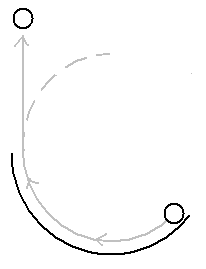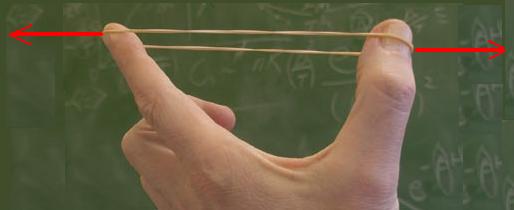
The Law of Force and Acceleration has been in the background throughout this course. At various times it was asserted that forces on an object had to cancel if it was to remain at rest. Unbalanced forces were used to launch rolling balls. A ball rolling on a table top will go in a straight line; if we want it to change direction of motion, we must exert a force on it. The force is towards the center of the curve. If the curve is gentle, the change in velocity is gradual (the acceleration is small).
This explains why steering a ball by bouncing it from a plastic strip wall doesn't work well. The bounce is an abrupt change in direction and thus a large force acting on the ball., and requires a large acceleration force that knocked the wall out of the way; instead, we changed the direction of motion more gradually, so that the acceleration and force would be smaller.

The ball pushes on the wall (just as the wall pushes on the ball), and the ball moves, but the speed does not change. No energy is being transferred because the direction of the force is perpendicular to the wall, while the motion is along the wall; for transfer of energy, the force and the motion should be in the same direction. However, when you try to bounce the ball off of a wall, the wall is pushed backwards, and the ball loses significant energy in the process.
Dropping an egg
As an egg falls, only the gravitational force is acting. There is an unbalanced force on the egg, and then it accelerates downward. When the egg arrives at the floor, it must stop. Changing the speed in a very short time requires a very large acceleration; the floor exerts a very large upwards force to prevent the egg from continuing into the basement. And so the egg breaks.
To emphasize the point, let's put some numbers in. If you drop an egg a meter, its speed just before it hits the floor is about 4 m/sec. After the egg has come into contact with the floor, perhaps it can change shape a little bit, but certainly no more than a few millimeters. Then the back end of the egg will have to stop moving within a thousandth of a second. Changing the speed from 4 m/sec to zero in 0.001 seconds requires an acceleration of 4000 m/sec2. Multiply that by the mass of the egg (0.1 Kg) to get the force of floor on egg: 400 N, which is 400 times the weight of the egg! No wonder it breaks!
When you dropped the ball of clay, you could see the evidence of the large force in the deformation of the bottom of the ball, which requires a force that is much larger than the weight of the ball.
Pushing a car
You can get a car rolling on a level road by pushing on it. If you have
ever tried this, you surely noticed that at first very little seems to be
happening, but as you continue to push, it goes faster and faster. This
is an example of the Law of Force and Acceleration in which the mass is very
large: the mass of a car is somewhat over 1000 Kg. Then if you only feel like
exerting 200 N (40 pounds),
Shooting a rubber band

When you stretch a rubber band, there are two forces acting on it, as
shown in the diagram. Now if you let go, the force at the back end is no
longer present, but the force on the front end is. So now there is an unbalanced
force acting on the rubber band. This causes the rubber band to accelerate
in the direction of the remaining force, and the acceleration is large because
the mass is small. Zip! The rubber band flies across the room. (This example
becomes complicated if you think about it too long, because the rubber band
is changing length while it is accelerating. Different parts are travelling at
different speeds! OK, don't think about that part.)